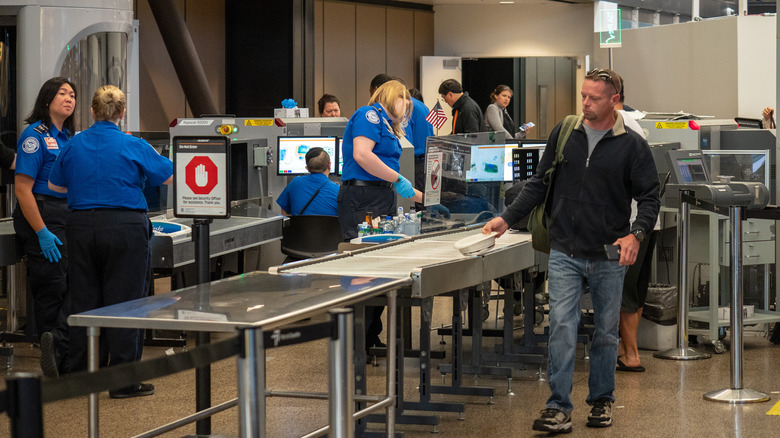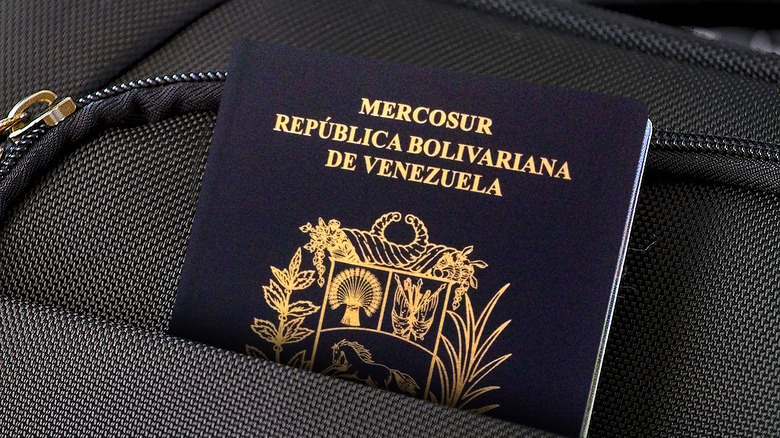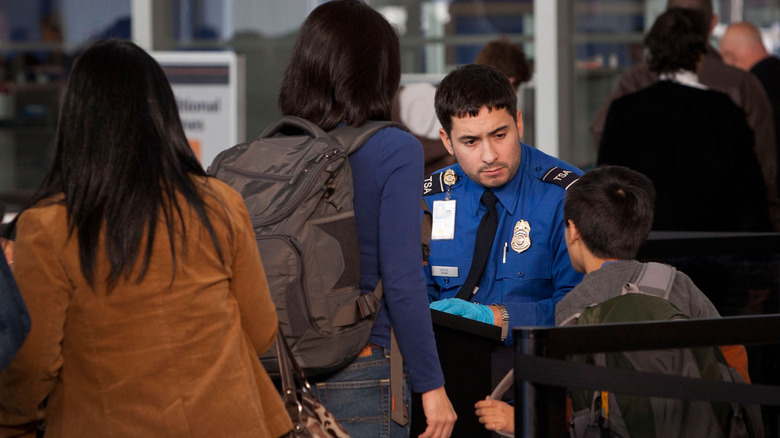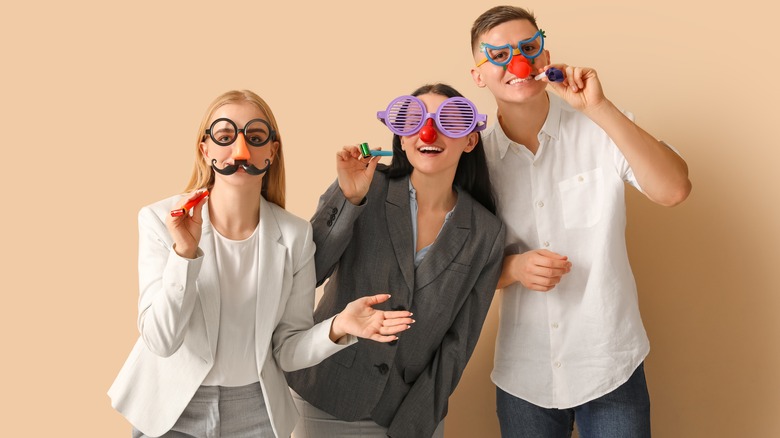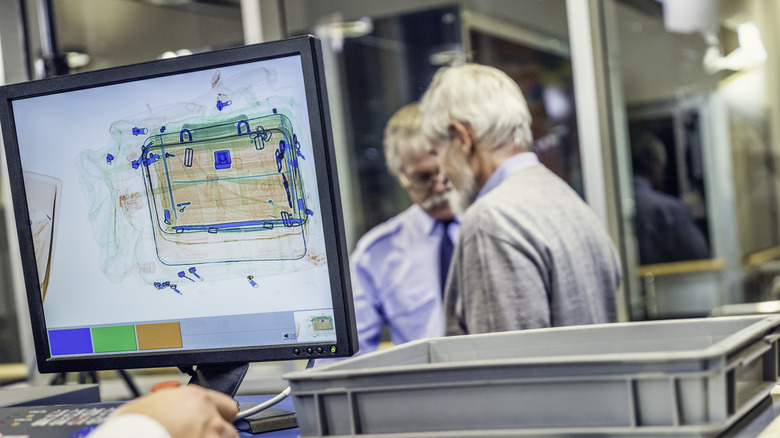The Odd Reasons TSA May Have Pulled You Aside For Additional Screening
Security at the airport is no one's favorite thing. Whether it's because of the long lines or, worse, you see SSSS on your boarding pass, and even if you're a TSA PreCheck holder, sometimes TSA can be unpredictable. Travelers who purchased and have Clear access, with the ability to pop to the head of security lines, might be surprised with additional screening. That's because it is the job of the TSA to monitor behavior of all passengers regardless of status.
"TSA is responsible for ensuring that all systems and programs, including those provided by private companies, meet requisite standards and will take necessary steps to ensure security needs are met," the agency said in a statement to The Washington Post after a security breach at Clear in 2023. "Accurate and reliable verification of passenger identity is foundational to aviation security and effective screening by TSA."
While some additional screenings are, truly, random, not all of them are. There are a handful of reasons why TSA may have picked you from a crowd for a double check before boarding. From traveling to high risk countries to accidental name matches, some of the screening reasons are trackable.
High risk travel
Travelers who are going or have been to a place considered high risk by the U.S. State Department may be taken for additional screening. Those locations can vary from time to time, so it's good to be aware of what countries are currently listed. As of this writing, some of the countries that were recently updated on the "Level 4: Do Not Travel" list include Venezuela, Iraq, and Burma.
A frequent traveler and journalist, Elizabeth Preske, learned the high risk additional screening lesson after going to Turkey. She wrote on TripSavvy that she received multiple SSSS boarding pass marks after that trip. She ended up applying for redress to get off of whatever secondary screening list she ended up on after that trip.
"Since receiving my redress number, my flights have been relatively stress-free, although [Department of Homeland Security Traveler Redress Inquiry Program] DHS TRIP 'cannot guarantee' that my future travels will be 'delay-free,'" she wrote. "Still, it's much less likely to happen." This program is a way for travelers to resolve ongoing screening issues and alert TSA that they are not, in fact, a security risk.
False positive identity detection
Do you have a common name? Or perhaps share a name with someone on the no-fly list? That could be the reason behind your random additional screening. It's called a false-positive and is another reason why some passengers apply for the Redress Inquiry Program. Even Senator Ted Kennedy accidentally ended up on the no-fly list in 2004, so these mix-ups happen. Unfortunately, when they do, it can cause significant issues in your travel from delays to denied boarding.
The FBI's Terrorist Screening Center oversees The Terrorist Screening Database, which is commonly known as the no-fly list. It was created in 2003 after the attacks of September 11, 2011, as a way to keep an eye on known or suspected terrorists. This problem is not just an American one either, as false positives can happen with any country's no-fly list just as it does in Canada. Traveler Zamir Khan told CBC in 2018 that his 3-year-old child was a false positive at a Canadian airport.
According to the FBI, the majority of individuals on the list are not Americans and have no connection to the United States. It is also not possible to check one's status on the list, so whether or not you will have a false positive is relatively unknown until it happens to you. As of 2017 there were about 1.2 million people on the list and 4,600 were U.S. citizens or permanent residents, per The Intercept.
Behavior triggers
Otherwise innocuous behaviors like coughing or yawning could also trigger an additional screening if you're spotted by a Behavior Detection Officer (BDO). That's because these officers are part of TSA's Screening of Passengers by Observation Techniques (SPOT) program. SPOT uses a list of behaviors that could identify high levels of stress, fear, or deception.
These 92 behaviors can lead to passengers being taken for additional screening if identified by one of the BDOs as a potential risk. That said, TSA told The Intercept in 2015 that one behavior isn't going to trigger an extra screening. So, anxious fidgeting on its own is unlikely to get you pulled aside. That's likely good news for anxious fliers everywhere.
Since the SPOT program gives spotted travelers a score, it seems there are also ways those scores can be reduced. For instance, married couples over 55 get a 2-point score deduction. Even with some knowledge of the program being public, it hasn't stopped leaks from happening. The ACLU even sued the TSA over the controversial SPOT program in 2015.
How you've dressed
Since part of a TSA agent's job is to verify your identity and screen for hidden objects, it only makes sense that clothes are part of the equation. Wearing a costume or disguise, for example, could sort you into another screening. Obviously something like a full face mask, too — like those you'd wear with a costume — aren't advised. You'll also want to avoid inappropriate clothing which could get you removed from a flight and make future travel more difficult with security.
But more commonly, passengers should remove or not wear bulky clothes through security. Doing so will likely end in a pat down or additional screening. The TSA defines bulky clothing as "a garment that is very loose or doesn't conform to the contour of the person." The agency uses examples such as "oversized pullover hoodies, large sweaters, cardigans, and ponchos," while warning that a traveler who "cannot or is not willing to remove a light outer garment or bulky clothing" must alert the officer, which will possibly result in more screenings.
Jewelry can also trigger an additional screening if it sets off an alarm. TSA advised Who What Wear that passengers avoid wearing rings that cover multiple fingers, bulky pieces, big belt buckles, and thick bracelets. And it always helps to know before traveling what full-body scanners at airport security really show.
Packing prohibited items
Passenger screenings is only part of the TSA experience. While you're going through airport security your belongings will also be examined. If something triggers a second look, you may go through additional screening and/or a thorough examination of your luggage. Obviously some things like weapons are prohibited in carry-on items. Yet travelers continue to try and bring them through.
Per a report of the most common prohibited carry-on items in Idaho airports, TSA outlined that all the Top 10 items were weapons or weapon potential items. These included ninja throwing stars, hatchets, crow bars, realistic replica rocket propelled grenades, and even grenade-shaped bottles of hot sauce. Other things that aren't permitted in carry-on bags and will result in additional screening include flammable items, sports equipment, self-defense items, and explosives.
If you're packing and realize you aren't sure about something, you can always reach out to TSA. There are several easy ways to get any question you have for TSA answered. You can also ask agents while you're at the airport before security if you are unsure.
